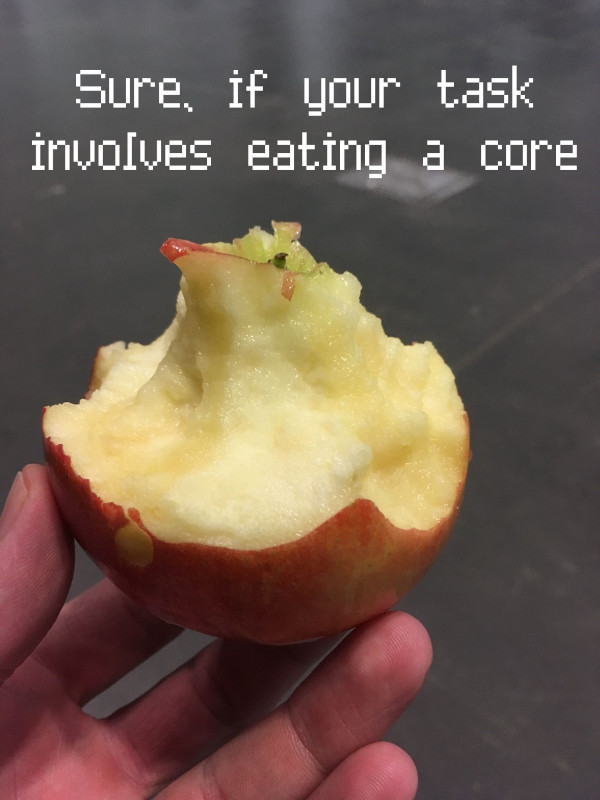I know I need to eat an apple, but I can’t remember how to take the first bite
You know, when you’re watching a coding tutorial and you think things are going great? You’re even a few steps ahead of the instructor. The world is your oyster, and your oyster is a perfectly encapsulated method with no exception errors for miles. It’s a good feeling, right?
But then, the tutorial ends. You throw away your freshly coded pearl-making shell and decide to test yourself by building the oyster from scratch.
You freeze. What the hell was step one, again?
My first, and so far still biggest, frustration when learning how to make games is the post-tutorial paralysis.
As the steps come, those steps seem logical enough. Every instruction reads like a natural progression. Like chewing once and then chewing again. “Of course I’m meant to chew again; there’s still food in my mouth and chewing feels right.” Run that while loop until the food is masticated enough to swallow. There comes a point in all tutorials, about 75% through, when I think “if my internet went out right now, I could finish this lesson. I don’t even need the rest of this tutorial.” In other words, the tutorial has taught me that swallowing is the natural next step after making mouth mush.
But then I get cocky. I close out the tutorial and I try taking a bite all by myself. Suddenly, I’ve never held an apple before. I have no idea what to do first.
This post-tutorial paralysis still happens to me a lot, though thankfully, a lot less than it did when I first started learning how to code.
Part of this paralysis comes from the inherent problems with learning by tutorial. Tutorials are often meant to teach a specific task, not a general concept. I don’t advocate avoiding tutorials as a beginner. Task-oriented tutorials can still be helpful simply by their required exposure to a system. But it remains true that tutorials are designed to teach rote processes. Rote process isn’t very conducive to learning.
Tutorial paralysis is exacerbated by the near-infinite nature of task solutions. One tutorial “teaches” to bite an apple by applying pressure from your lower jaw while another “teaches” to apply pressure from the incisors, while a third says to rotate the apple 90 degrees along the x axis. As a beginner you fear there’s only one way to bite an apple, and to find that right way is a battle unto itself.

So, maybe there isn’t a single right way! Freedom acquired, right?
Well, no.
This idea that this apple-eating program can be approached in infinite different ways only furthers my paralysis. Even with infinite possibilities, I still tell myself that there is one ideal way of doing a thing. If I understood the problem well enough, then there is still an ideal, right? Infinite solutions don’t restrict a perfect solution, right?
This is much scarier. Knowing that I’m learning from someone who may not know this ideal (or that, I am not smart enough to understand the problem well enough to know if this person is tutorializing to an ideal), is the blind leading the blind. I don’t know what I don’t know.
Over time, I’ve come to terms with this fallacy of the attainable ideal. “Attainable” being the key word. I still feel there’s an ideal; I’m just getting more comfortable with understanding that it’s unattainable. Or, if it is attainable, I’ll never know that I’ve attained it. I’m blind, but I know I’m blind and will never not be blind, so I accept my blindness.
TL;SRiT (Too Long; Still Read it, Though):
There are infinite ways to eat an apple. Some may be better than others, but that doesn’t mean you shouldn’t eat the apple. And over time, you’ll learn new ways to eat new apples and perhaps, maybe, possibly (though I have my doubts) you’ll find out that some apples are best eaten in certain ways. At that moment, you will have become an apple eating master and will sound like a douche when you tell other people that they eat apples the wrong way.
If you are reading this and are not me, check out a few games I’ve made here: https://calebjross.itch.io/


